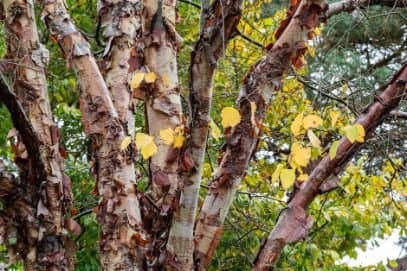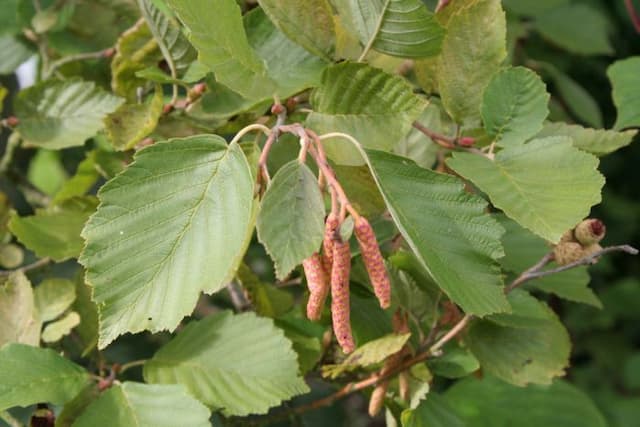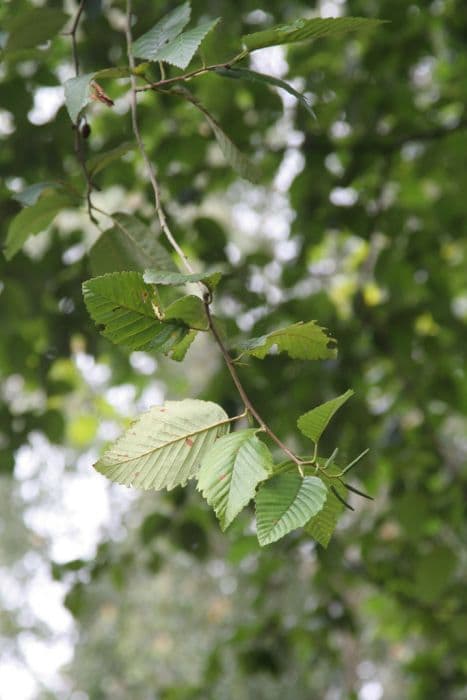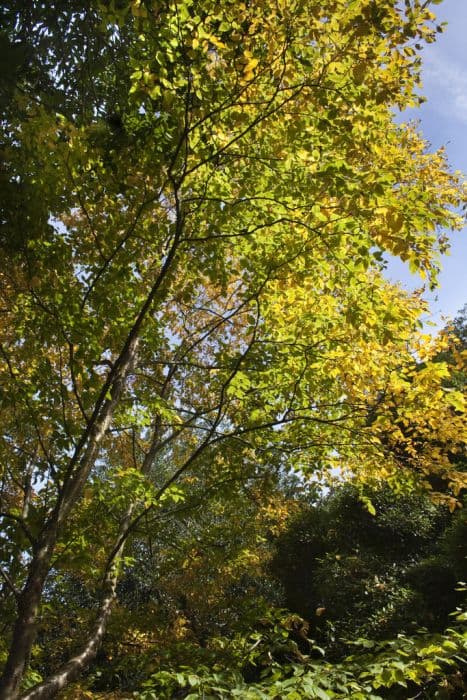Dahurian Birch Betula dauurica 'Maurice Foster'

ABOUT
Betula dauurica 'Maurice Foster', commonly known as the Daurian Birch, is characterized by its appealing aesthetic that adds ornamental value to landscapes. The most striking feature of the plant is its bark, which is distinctive and can vary in color but often presents itself in shades of white or cream with a smooth texture that may become slightly furrowed as it matures. This feature is particularly prominent in the winter months, adding visual interest to gardens even in dormancy. The foliage of the Daurian Birch is made up of leaves that are typically green, with a lush appearance during the growing season. These leaves may turn a range of yellow colors, providing a delightful display of autumnal hues before they drop. The leaves are often oval to triangular in shape, with serrated edges that create a delicate and textured look. Supporting the leaves, the branches of the plant are arranged in a way that gives it an overall graceful and slightly weeping habit. The branches can create a canopy that offers dappled shade beneath it during spring and summer months. In the springtime, the Daurian Birch produces catkins, which are long, slender flower clusters that can be quite noticeable and add to the plant's ornamental value. These catkins typically emerge before the leaves fully unfurl and can be an attractive feature to both humans and wildlife. Overall, the appearance of Betula dauurica 'Maurice Foster' is one of charm and understated beauty, making it a beloved choice for gardeners looking to add a touch of elegance to their outdoor spaces. Through the seasons, its changing colors and textures provide continual interest, contributing to its popularity.
About this plant
 Names
NamesFamily
Betulaceae
Synonyms
Daurian Birch, Maurice Foster Birch
Common names
Betula dauurica 'Maurice Foster'.
 Toxicity
ToxicityTo humans
Birch trees, including Betula dauurica 'Maurice Foster', are generally not considered toxic to humans. However, as with any plant, individual allergies or sensitivities may exist. If a person has a known allergy to birch pollen or other plant parts, ingestion or contact could cause allergic reactions, which might include skin irritation, itching, swelling, or difficulty breathing if the allergy is severe. It is always best to exercise caution and avoid ingesting or handling plants if you are unsure of your sensitivities.
To pets
Birch trees are not commonly known to be toxic to pets. The Betula dauurica 'Maurice Foster' is not an exception and is generally considered safe around pets. However, ingestion of any non-food plant material can potentially cause mild stomach upset in some animals. If a pet ingests a large amount of birch tree plant material and exhibits signs of distress such as vomiting or diarrhea, it is advisable to consult a veterinarian.
 Characteristics
CharacteristicsLife cycle
Perennials
Foliage type
Deciduous
Color of leaves
Green
Height
30 feet (9 meters)
Spread
20 feet (6 meters)
Plant type
Tree
Hardiness zones
3
Native area
Asia
Benefits
 General Benefits
General Benefits- Aesthetic Appeal: Birch trees, including Betula dauurica 'Maurice Foster', offer stunning visual interest in gardens and landscapes with their peeling barks, graceful foliage, and elegant forms.
- Seasonal Interest: They often provide year-round interest with foliage that changes color in the fall, attractive bark in the winter, and fresh green leaves in the spring and summer.
- Wildlife Habitat: Birches can serve as a habitat for various species of wildlife, offering shelter and food such as seeds and sap.
- Soil Stabilization: The root systems of birch trees can help stabilize soil and prevent erosion, particularly in sloped areas of the landscape.
- Shade: Mature birch trees, including Betula dauurica 'Maurice Foster', can provide significant shade, creating cooler areas in gardens and reducing the need for air conditioning in nearby homes.
- Privacy: When planted in groups or rows, birch trees can act as a natural privacy screen, blocking unwanted views and reducing noise pollution.
 Medical Properties
Medical PropertiesThis plant is not used for medical purposes.
 Air-purifying Qualities
Air-purifying QualitiesThis plant is not specifically known for air purifying qualities.
 Other Uses
Other Uses- Woodworking: The wood of the Betula dahurica can be utilized in woodworking projects for making small decorative items or turned objects, as it is known for its fine grain and workability.
- Landscaping: With its attractive bark and foliage, the plant is used in landscaping to create a focal point or to add visual interest in gardens and parks.
- Natural dye: The bark can be used to produce a natural dye for coloring fabrics or yarns in a range of brown tones.
- Erosion control: Deep root system can help stabilize soil, making it useful for planting on slopes or in areas prone to erosion.
- Tannin extraction: The bark may be used to extract tannins, which can be used in the leather tanning process or as a natural preservative.
- Photography: The distinctive visual character of the tree is popular with photographers, especially in autumn when the leaves turn yellow.
- Wildlife habitat: Provides shelter and food for various birds and insects, enhancing biodiversity in its native environment.
- Artistic inspiration: Artists may use the tree as a subject or inspiration due to its elegant form and texture.
- Frost protection: Can be planted as a windbreak to protect more delicate plants from cold winds and frost.
- Education: Used in educational settings such as arboretums and botanical gardens to teach about dendrology and plant sciences.
Interesting Facts
 Feng Shui
Feng ShuiThe Daurian Birch is not used in Feng Shui practice.
 Zodiac Sign Compitability
Zodiac Sign CompitabilityThe Daurian Birch is not used in astrology practice.
 Plant Symbolism
Plant Symbolism- Purity and Cleansing: Birch trees often symbolize purity and cleansing because of their bright white bark, symbolizing a clean slate or new beginnings.
- Renewal and Rebirth: Similar to their symbolism of a fresh start, birches are often associated with renewal and rebirth due to their ability to easily repopulate areas cleared by fire or logging.
- New Adventures: The graceful and slender form of the birch tree stands as a metaphor for moving forward, marking it as a totem of new adventures and exploration.
- Adaptability: Due to the birch tree's resilience and ability to thrive in various climates and soils, it stands as a symbol of adaptability and resourcefulness.
- Protection: In various cultures, birch trees are believed to ward off evil and negativity, offering symbolic protection to those around them.
- Love and Fertility: In some folklore, the leaves and twigs of birch trees are associated with love and fertility, and it is used in rituals and festivals celebrating these concepts.
 Water
WaterThe Daurian Birch requires consistent moisture, especially during its growing season in the spring and summer. Water the plant deeply once or twice a week, ensuring that the soil is moist but not waterlogged. During dry spells, you may need to water more frequently. Each watering session should provide enough water to saturate the root zone, which for a mature tree may equal to 10-15 gallons. Decrease watering in the fall and winter when the tree is dormant to prevent root rot.
 Light
LightThe Daurian Birch thrives in full sunlight to partial shade. Plant it in a location where it can receive at least six hours of direct sunlight daily. If the climate is particularly hot, it can benefit from some afternoon shade to prevent scorching. The ideal spot for this birch would be an open area with ample morning sunlight and some protection from the intense afternoon sun.
 Temperature
TemperatureThe Daurian Birch is hardy and can withstand a range of temperatures, but it performs best in regions that offer a cool to moderate climate. It is known to survive temperatures as low as -40°F and as high as 90°F. However, the ideal temperature for this birch would be between 60°F and 75°F, which promotes optimal growth and health.
 Pruning
PruningPrune the Daurian Birch to remove any dead or damaged branches, to shape the tree, and to encourage healthy growth. The best time for pruning is late winter or early spring before new growth begins, as this minimizes sap loss and allows for easier identification of necessary cuts. Thin out the canopy to allow light and air to reach the inner branches, and remove any suckers or unwanted branches annually.
 Cleaning
CleaningAs needed
 Soil
SoilThe Daurian Birch requires well-drained soil with a slightly acidic to neutral pH, generally around 5.5 to 7.0. A soil mix composed of loam, sand, and organic matter, such as compost or well-rotted manure, would provide the necessary drainage and fertility. Mulching can help maintain soil moisture and temperature while providing additional organic matter as it decomposes.
 Repotting
RepottingDaurian Birch trees do not typically require frequent repotting as they are usually planted directly in the ground. If grown in containers, young trees may need repotting every 2-3 years to provide sufficient space for root growth. Mature trees should be planted in their permanent outdoor location and would not require repotting.
 Humidity & Misting
Humidity & MistingDaurian Birch trees are adaptable to a wide range of humidity levels, but they typically prefer moderate humidity. Excessive humidity can promote fungal diseases, so it's important to ensure good air circulation around the tree. Outdoor conditions usually provide the right amount of humidity without the need for intervention.
 Suitable locations
Suitable locationsIndoor
Not suitable for indoor growing; requires outdoor environment.
Outdoor
Plant in well-drained soil, full sun to partial shade, ample space.
Hardiness zone
2-7 USDA.
 Life cycle
Life cycleThe life cycle of the 'Maurice Foster' Birch (Betula dauurica 'Maurice Foster') begins with seed germination, which requires exposure to cold temperatures to break dormancy. Once germinated, the seedling grows rapidly due to its aggressive root system and can quickly establish itself. As a sapling, the 'Maurice Foster' Birch will start to develop its characteristic peeling bark and oval-shaped leaves, with growth continuing rapidly if conditions are optimal. Reaching maturity, the tree will produce catkins in early spring before the leaves emerge, with male catkins shedding pollen and female catkins developing into small winged seeds by autumn. Mature trees exhibit increased resistance to environmental stresses but may require some protection from harsh conditions and pests. After decades, as the tree reaches the end of its lifespan, it will gradually decline and eventually die, providing opportunities for new seeds to germinate and start the life cycle anew.
 Propogation
PropogationPropogation time
Spring to Summer
For Betula dahurica 'Maurice Foster', commonly referred to as Dahurian Birch, the most popular method of propagation is by seed. The best time to sow seeds is in the late winter or early spring. Since the seeds are tiny, they should be surface-sown on well-draining, moist potting mix, as they need light to germinate. Cover the pot with a plastic wrap or place in a cold frame. Germination can be irregular, but gentle warmth may speed up the process. Once seedlings emerge, they should be grown in cooler conditions until they are strong enough to be transplanted outdoors after the risk of frost has passed.









